Balbharti Maharashtra State Board Class 8 Science Solutions Chapter 19 Life Cycle of Stars Notes, Textbook Exercise Important Questions and Answers.
Std 8 Science Chapter 19 Life Cycle of Stars Question Answer Maharashtra Board
Class 8 Science Chapter 19 Life Cycle of Stars Question Answer Maharashtra Board
1. Search and you will find:
Question a.
Our galaxy is called ………… .
Answer:
Our galaxy is called the Milky Way and Mandakini.
![]()
Question b.
For measuring large distances, ………… is used as a unit.
Answer:
For measuring large distances, the light year is used as a unit.
Question c.
The speed of light is …………. km/s.
Answer:
The speed of light is 300000 km/s.
Question d.
There are about ………… stars in our galaxy.
Answer:
There are about 100 billion stars in our galaxy.
Question e.
The end stage of the Sun will be …………. .
Answer:
The end stage of the Sun will be a white dwarf.
![]()
Question f.
Stars are born out of ………… clouds.
Answer:
Stars are born out of interstellar clouds.
Question g.
Milky way is a ………. galaxy.
Answer:
Milky way is a spiral galaxy.
Question h.
Stars are gigantic spheres of ………… gas.
Answer:
Stars are gigantic spheres of hot gas.
Question i.
The masses of other stars are measured relative to the mass of the …………. .
Answer:
The masses of other stars are measured relative to the mass of the Sun.
![]()
Question j.
Light takes ……………. to reach us from the Sun while it takes …….. to reach us from the moon.
Answer:
Light takes about 8 minutes to reach us from the Sun while it takes about 1 second to reach us from the moon.
Question k.
The larger the mass of a star, the faster is its ……….. .
Answer:
The larger the mass of a star, the faster is its evolution.
Question l.
The number of fuels used in the life of a star depends on its …………. .
Answer:
The number of fuels used in the life of a star depends on its mass.

2. Who is telling lies?
Question a.
Light year is used to measure time.
Answer:
False. (Light year is used to measure distance.)
Question b.
End stage of a star depends on its initial mass.
Answer:
True.
Question c.
A star ends its life as a neutron star when the pressure of its electrons balances its gravity.
Answer:
False. (A star ends its life as a neutron star when the pressure of its neutrons balances its gravity.)
Question d.
Only light can emit from the black hole.
Answer:
False. (Not even light can be emitted by a black hole.)
![]()
Question e.
The Sun will pass through the supergiant stage during its evolution.
Answer:
False. (The Sun will pass through the red giant stage during its evolution.)
Question f.
The Sun will end its life as a white dwarf.
Answer:
True.
3. Answer the following question:
Question a.
How do stars form?
Answer:
There are huge clouds of gas and dust in the empty spaces between the stars in a galaxy. These clouds are called interstellar clouds. The size of an interstellar cloud is about a few light years.

When an interstellar cloud starts contracting due to some disturbance, its density and temperature increase. This results in formation of a dense sphere of hot gas and nuclear energy generation starts at the centre of the star. Therefore, the gas sphere becomes self-luminous. Thus a star is formed, i.e., a star is born.
A huge interstellar cloud can produce thousands of stars at a time.

![]()
Question b.
Why do stars evolve?
Answer:
Although stars appear stable for quite a long period of time, their properties do change, though very slowly. A change in the properties of a star, leading to its passing through different stages, is called evolution of the star. Burning of the fuel at the centre of the star and a gradual decrease in its amount is the main reason of evolution of a star.
Question c.
What are the three end stages of stars?
Answer:
- Stars having initial mass less than 8 times the mass of the Sun ultimately become white dwarfs.
- Stars having initial mass between i 8 and 25 times the mass of the Sun ultimately become neutron stars.
- Stars having initial mass larger than 25 times the mass of the Sun ultimately turn into black holes.
Question d.
Why was the name black hole given?
Answer:
When a star having initial mass larger than 25 times the mass of the Sun reaches its end stage, its gravitational force and density increase exponentially. All nearby objects get attracted towards the star and nothing can come out of it, not even light. All incident light is absorbed by the star. We can probably see a very minute black hole at its place. Hence, the name is given as black hole.
![]()
Question e.
Which types of stars end their life as a neutron star?
Answer:
Stars having initial mass between 8 and 25 times the mass of the Sun end up as neutron stars. When these stars pass through ( the supergiant stage, their size increases to 1000 times. Huge explosion that occurs in the last stage of these stars is very powerful and very high energy is given off. After the huge explosion, called the supernova explosion, their central portion contracts in size to about 10 km. In this stage, such stars are completely made up of neutrons and hence are called neutron stars.
4. A. If you are the Sun, write about your properties in your own words.
B. Describe white dwarfs.
Question A.
If you are the Sun, write about your properties in your own words.
Answer:
If you are the Sun, write about your properties in your own words.
Answer:
There are billions of stars in the galaxy called the Milky Way and Mandakini. I am one of the small stars called the Sun. I have my own family called the solar system. There are planets, satellites, asteroids, comets and meteors in my family. My mass is 2 × 1030 kg which is about 3.3 lakh times that of the earth. With a radius of 695700 km, my size is about 100 times that of the earth. My surface temperature is about 5800 K while it is 1.5 × 107 K at the centre.
72 % of my mass consists of hydrogen while 26 % consists of helium. Rest 2 % is made up of elements heavier than helium. I am about 4.5 billion years old and the scientists on the earth have concluded that not much change has taken place in my properties during this period. According to the scientists, in the end stage of my life, I will turn into a red giant star. Thereafter, I will first explode and then contract to become as small as the earth. I will appear small as well as white and hence, I will be called a white dwarf. This will be my last stage for ever.
![]()
Question B.
Describe white dwarfs.
Answer:
Depending on the initial mass, stars can reach one of the three end stages. White dwarf is one such stage of stars having initial mass less than 8 times the mass of the Sun. These stars undergo huge expansion and their radius increases by a factor of 100 to 200. These stars appear reddish because of their large size and lower temperature. Hence, these stars are also called red giant stars.
At the end of their evolution, these stars explode, their outer gas envelope is thrown outward and the inner part contracts to the size of the earth. However, the density in the star becomes very high. In this stage, the pressure due to electrons becomes independent of temperature and sufficient to balance the gravitational force for ever.
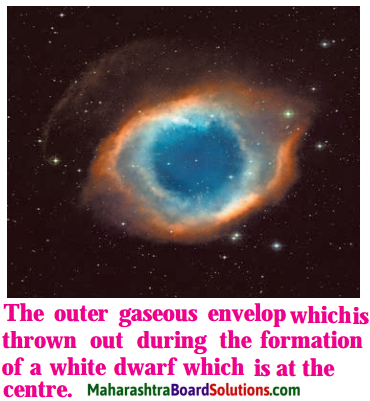
In this stage, such stars look white and due to their small size they are called white dwarfs.
Can you recall?
Question 1.
What is a galaxy?
Answer:
A system of billions of stars, their planetary systems and interstellar clouds of gas and dust held together by gravitational attraction is called a galaxy.
Question 2.
What are the different constituents of our solar system?
Answer:
The different constituents of our solar system are as follows :
- Sun as a star.
- Eight planets, namely, Mercury, Venus, Earth, Mars, Jupiter, Saturn, Uranus and Neptune; of which Mercury, Venus, Earth and Mars are made up of rocks and minerals, while Jupiter, Saturn, Uranus and Neptune are made up of gases.
- Natural satellites of some planets revolving around the respective planets.
- Asteroids located between Mars and Jupiter.
- Comets made up of ice, dust and gases.
- Meteors and meteoroids.
![]()
Question 3.
What are the major differences between a star and a planet?
Answer:
- Nuclear/atomic explosions regularly take place at the centre of stars. This causes the discharge of heat and light. Hence, stars shine. Planets do not discharge any light. They are visible due to the light reflected by them.
- Stars are very big in size and massive relative to planets.
- Stars twinkle, planets do not.
- Stars are made up of hydrogen, helium and other light elements.
- Planets are made up of solid, liquid or gaseous substances or a combination thereof.
Question 4.
What is a satellite?
Answer:
An astronomical object orbiting a planet is called a satellite.
Question 5.
Which is the star nearest to us?
Answer:
The star nearest to us is the Sun.
![]()
Project:
Question 1.
Use your imagination and make models of the Milky Way and the solar system.
Answer:
N.B. Students can make these models and display the same in science exhibition. You can use sand, scrap material, stones, pebbles, marbles, pieces of glass, beads, etc.
Question 2.
Write the effects: If the Sun disappears ………..
Answer:
N.B. You can write the effects with the help of the following points:
- No sunrise, no sunset, no beauty of morning and evening wee hours.
- In the absence of the gravitational force due to the Sun, the earth will drift away in the galaxy.
- Darkness, no source of energy, end of life on the earth.
- Moon will be invisible.
- The temperature of the earth will fall below the freezing point of water. All oceans will also freeze.
- Even the atmosphere will freeze and fall on the earth. This will cause more cosmic rays to reach the earth.
Class 8 Science Chapter 19 Life Cycle of Stars Important Questions and Answers
Match the columns:
Question 1.
| Column ‘A’ | Column ‘B’ |
| 1. Gravitational force | a. Alpha Centauri |
| 2. The star nearest to us other than the Sun | b. 2 × 1030 kg |
| 3. Mass of the Sun | c. 10 30 g |
| d. towards the centre of a star or a planet |
Answer:
| Column ‘A’ | Column ‘B’ |
| 1. Gravitational force | d. towards the centre of a star or a planet |
| 2. The star nearest to us other than the Sun | a. Alpha Centauri |
| 3. Mass of the Sun | b. 2 × 1030 kg |
![]()
Question 2.
Mass of the star:
| Column ‘A’ | Column ‘B’ |
| 1. < 8 MSun | a. Proton star |
| 2. between 8 and 25 times MSun | b. Black hole |
| 3. > 25 MSun | c. Neutron star |
| d. White dwarf |
Answer:
Mass of the star:
| Column ‘A’ | Column ‘B’ |
| 1. < 8 MSun | d. White dwarf |
| 2. between 8 and 25 times MSun | c. Neutron star |
| 3. > 25 MSun | b. Black hole |
![]()
Answer the following questions in one sentence each:
Question 1.
Name the star nearest to the earth.
Answer:
The Sun.
Question 2.
Other than the Sun, which is the star nearest to the earth?
Answer:
Alpha Centauri.
Question 3.
What would be the last stage of the Sun?
Answer:
The last stage of the Sun would be white dwarf.
Question 4.
Name two forces that act on any star.
Answer:
Gravitational force and the force due to the pressure of hot gas are the two forces that act on any star.
![]()
Question 5.
What is a black hole?
Answer:
A black hole is the end stage of a quite big star, where due to the extremely high gravitational force, nothing, not even light, comes out.
Answer the following questions:
Question 1.
How is stability of stars maintained?
Answer:
Properties of a star remain unchanged for quite a long time. The gravitational force and the force due to the pressure of the hot gas act together on a star. The gravitational force acts towards the centre of the star and tries to bring the gas particles close together. Hot gas shows the tendency to spread and its force acts away from the centre of the star. This force tries to disperse the gas particles. A balance between the gravitational force and the force due to the hot gas keeps the star stable.
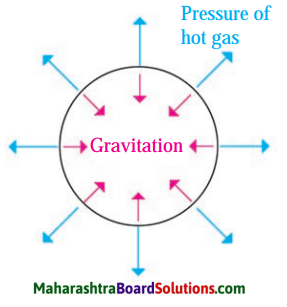
However, if the magnitude of any one force is more than that of the other force, the star either contracts or expands depending upon which force dominates.
Question 2.
Why is the Sun called an ordinary star?
Answer:
The star nearest to the earth is the Sun. Hence, it appears quite big and bright. There are billions of stars in our galaxy called the Milky Way and Mandakini which are greater or lower in mass, size and temperature than the Sun. Hence, the Sun is called an ordinary star.
![]()
Do you know?
When the Sun will become a red giant, its diameter will increase so much that it will swallow Mercury and Venus. It is possible that the earth will also be absorbed by the Sun. It will take about 4-5 billion years for the Sun to reach this state.
Question 3.
Describe various stages of evolution of star.
Answer:
Though the properties of a star remain unchanged for quite a long time, this situation is never static. A star passes through different stages. This process is called the evolution of a star.
Important stages of the evolution of a star are as follows:
1. Initial stage of stability: The gravitational force and the force due to the pressure of the hot gas act together on a star. The gravitational force acts towards the centre of the star and tries to bring the gas particles close together. Hot gas shows the tendency to spread and its force acts away from the centre of the star.
This force tries to disperse the gas particles. A balance between the gravitational force and the force due to the hot gases keeps the star stable, as long as the energy generation continues at the centre of the star.
2. Burning of the fuel: As a star continuously emits energy, its energy constantly decreases. When the fuel at the centre of the star is exhausted, the energy generation stops and the temperature of the star starts decreasing. Decreasing temperature causes the gas pressure to decrease and the balance between the gravitational force and the force due to the gas pressure is no more maintained.
As the magnitude of the gravitational force is now more than that of the force due to the gas pressure, the star starts contracting. This causes another fuel to start burning, e.g. on exhausting hydrogen, helium starts undergoing fusion. Availability of multiple fuels depends on the mass of the star.
The higher the mass of the star, the more is the number of fuels used. The star either contracts or expands during the course of using these fuels. This may cause the imbalance between the gravitational force and the force due to the hot gas.
3. Total exhaustion of the fuel: When all fuels are exhausted, the energy generation in the star finally stops completely and the temperature of the star starts decreasing. The balance between the gravitational force and the force due to the gas pressure can no more be maintained. The evolution of the star ends and the star proceeds to its end stage.
4. End stage of a star: Once the fuel in the star is totally exhausted, the energy generation in the star stops and subsequently the gas pressure decreases, the star starts contracting and its density starts increasing. When the density becomes very high, some new types of pressures are generated which are independent of the temperature of the gas.
In such a case, the pressure remains stable despite low temperature and absence of any energy generation and thus the star remains stable for ever. This stage is the end stage of the star. Depending on the initial mass, stars can reach one of the three end stages.
- Stars having initial mass less than 8 times the mass of the Sun ultimately become white dwarfs.
- Stars having initial mass between 8 and 25 times the mass of the Sun ultimately become neutron stars.
- Stars having initial mass larger than 25 times the mass of the Sun ultimately turn into black holes.
![]()
Write short notes on the following:
Question 1.
End stages of stars having initial mass less than 8 times the mass of the Sun.
Answer:
These stars undergo huge expansion and their radius increases by a factor of 100 to 200 during their various stages of evolution. These stars appear reddish due to their lower temperature. Hence, they are called red giant stars.
At the end of evolution, these stars explode, their outer gas envelope is thrown out and the inner part contracts roughly to the size of the earth. Hence, the density of the star becomes very high. In this stage, the pressure due to electrons becomes independent of temperature and sufficient to balance the gravitational force for ever. Such stars look white and due to their small size they are called white dwarfs.
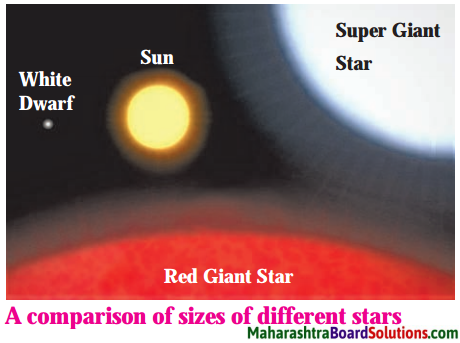
Question 2.
End stage of the stars having mass between 8 and 25 times the mass of the Sun.
Answer:
These stars pass through the red giant stage and later super giant stage, during which their size may increase to 1000 times. The huge explosion, called the supernova explosion, occurs in the last stage of the evolution. It is very powerful and very high energy is given off in this case.
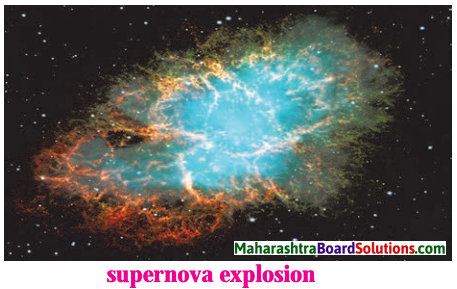
As a result, the stars are visible even during the day. Later their central portion contracts to about 10 km. In this stage, the stars are completely made up of neutrons and are called neutron stars. The pressure of these neutrons is independent of temperature and sufficient enough to balance the gravitational force for ever.
![]()
Question 3.
End stages of stars having mass larger than 25 times the mass of the Sun.
Answer:
After the supernova explosion, no pressure can balance the gravitational force. Hence these stars contract continuously and their gravitational force and density increase exponentially. All nearby objects get attracted towards these stars and not even light can come out of them. Light falling on these stars is completely absorbed by the star. We cannot see these stars. A very minute black hole is formed at the place of such a star. This is the end stage of these stars.
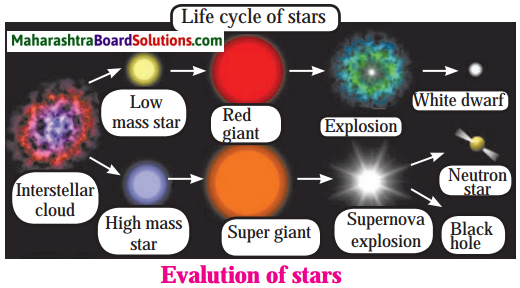
8th Std Science Questions And Answers:
- Human Body and Organ System Class 8 Questions And Answers
- Introduction to Acid and Base Class 8 Questions And Answers
- Chemical Change and Chemical Bond Class 8 Questions And Answers
- Measurement and Effects of Heat Class 8 Questions And Answers
- Sound Class 8 Questions And Answers
- Reflection of Light Class 8 Questions And Answers
- Man-made Materials Class 8 Questions And Answers
- Ecosystems Class 8 Questions And Answers
- Life Cycle of Stars Class 8 Questions And Answers
